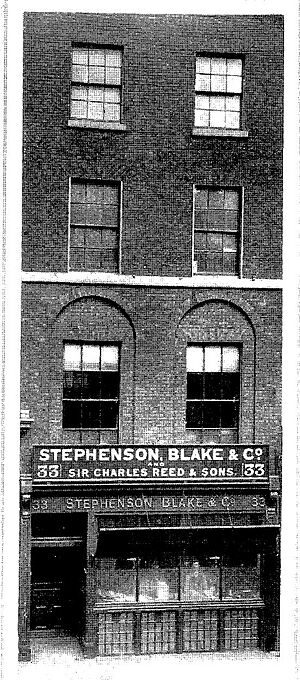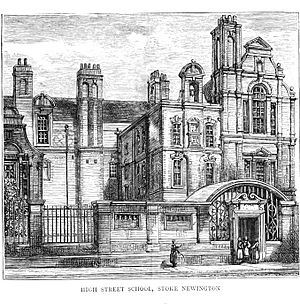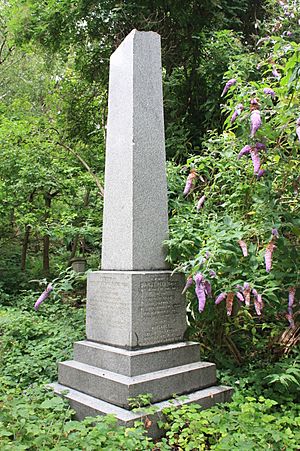Charles Reed (British politician) facts for kids
Quick facts for kids
Sir Charles Reed
|
|
|---|---|

Sir Charles Reed MP
|
|
| Born | 19 June 1819 |
| Died | 25 March 1881 (aged 61) |
| Nationality | British |
| Occupation | Politician |
| Spouse(s) | Margaret Baines |
| Children | 3 |
Sir Charles Reed (born June 19, 1819 – died March 25, 1881) was an important British politician. He served as a Member of Parliament (MP) for two areas: Hackney and St Ives. He also led the London School Board, which helped set up schools for everyone.
Charles Reed was also a successful businessman. He owned a company that made printing types. He was known for his charity work and for helping to protect important historical places in London. Queen Victoria even made him a knight in 1874 for his contributions.
Contents
Reed's Family Life
Charles Reed was the oldest son of Dr. Andrew Reed. His father was a well-known helper of others and a minister. Dr. Andrew Reed started many charities, including the London Orphan Asylum. He is remembered at Abney Park Cemetery with a tall monument.
Charles Reed married Margaret Baines. Her father, Edward Baines, was also an MP. Charles and Margaret had eight children: four sons and four daughters.
- Charles Edward Baines Reed (1845–1884) became a minister. He worked for the British and Foreign Bible Society. Sadly, he died in an accident in Switzerland.
- Andrew Holmes Reed (1848–1892) is buried near his brother Talbot. Their graves are marked by a special Celtic cross.
- Talbot Baines Reed (1852–1893) was a famous author. He wrote popular story books for boys.
- Kenneth Reed (died 1879) was the youngest son. He drowned in a canoeing accident before he turned twenty.
Charles Reed's Education
Charles Reed went to school at Madras House in Hackney. This school was known for its modern teaching methods in the 1800s. The school used a "Madras system." This meant older students, called "monitors," helped teach and supervise younger boys.
Reed's Business Journey
Charles Reed started his business career in 1836. He was an apprentice at a company that made wool products in Leeds. In 1839, he helped start a magazine called The Leeds Repository.
When he returned to London, he co-founded a company in 1842. This company, Tyler & Reed, was involved in printing and making typefaces. Typefaces are the different styles of letters used in printing.
Later, in 1866, Reed became a partner in the famous Fann Street Foundry. This company then became 'Reed & Fox'. This business became the foundation for his own company, Sir Charles Reed & Sons. Their office was at 33 Aldersgate Street in London.
The 'Reed' company name continued for many years after Charles Reed's death. Another company, Stephenson Blake & Co., bought Reed's business. At one time, Reed's was a very large company. However, it struggled to update its equipment as printing technology changed.
Even so, Reed's company had a hidden treasure: its old typefaces. Designs like the Clarendon typeface, which Charles Reed had bought, became very popular again. Today, many of Reed's typefaces are available for use on computers.
Charles' son, Talbot Baines Reed, also wrote an important book. It was about the history of typefounders in England. For a long time, it was the most complete book on this topic.
Helping Lifeboats: The Broadstairs Fund
There is a special fund linked to the Broadstairs lifeboat and Sir Charles Reed. It started in 1867. This fund helped sailors who risked their lives to save others near Broadstairs.
Here is a story told by Sir Charles Reed himself: "Eight boatmen from Broadstairs often saved people near the Goodwin Sands. One night, they rescued a French ship's crew in a terrible storm. But another boat claimed the reward for saving the ship. The Broadstairs men went to court but lost.
Then, they lost their own boat. The lawyers they hired demanded payment. The poor men had no money and were sent to prison. Sir Charles Reed was in Broadstairs at the time. He wrote to The Times newspaper asking for help.
In just one week, he received almost twice the money needed! The lawyers were paid, and the men were freed. The extra money was invested. The interest from this money was used to reward brave boatmen who saved lives along the coast."
Leading the London School Board
In 1870, Charles Reed was elected to the new London School Board. This board was created after a new law, the Elementary Education Act, was passed. This law aimed to provide education for all children, ending the need for charity schools.
The London School Board was very modern for its time. It was the first elected body to cover all of London. Also, women could vote for its members and even run for election themselves! Charles Reed became the vice-chairman and then the chairman of the board. He was still in this important role when he died in 1881.
Hackney's First MP
In 1868, Charles Reed became one of the first two Members of Parliament (MPs) for Hackney. This was a new role created by a law in 1867. He served as an MP in Britain's first Liberal government.
In the next election in 1874, he faced a strong opponent. However, Charles Reed still won. But there were questions about how the election was run, so a new election had to be held three months later. Charles Reed did not run again for Hackney at that time.
Liberals continued to be elected for Hackney until new constituencies were created in 1885.
Protecting Abney Park Cemetery
Charles Reed cared about London's green spaces and their educational value. He became involved with the Abney Park Cemetery. This was a special parkland that had once belonged to Lady Mary Abney. The famous hymn writer Dr. Isaac Watts had written hymns there.
People wanted to keep the site for its religious history and as an open space. It was also unique because it had an arboretum with 2500 different trees and shrubs. The cemetery's entrance was designed in an Egyptian style, showing it was open to people of all faiths.
Charles Reed understood how important this place was. He was elected as a director of the company that ran the cemetery. He served for 16 years, from 1866 to 1881. He played a key role in protecting the cemetery during these years.
Charles Reed himself is buried at Abney Park Cemetery. Soon after he died, the cemetery was taken over by a new company. This company later opened other cemeteries.
Saving Bunhill Fields
The Bunhill Fields burial ground is a very old open space in London. Many important historical figures were buried there. This was especially true for people whose religious beliefs were different from the main church.
The poet Robert Southey called Bunhill Fields the Campo Santo of the Dissenters. This means "Holy Field of the Dissenters." It showed how important it was as a burial place for religious figures like John Bunyan and Dr. Isaac Watts.
In 1865, a special committee was formed to stop the land from being built on. This was called the Bunhill Fields Preservation Committee. Charles Reed was the chairman of this committee.
Thanks to their work, a law was passed in 1867. This law protected Bunhill Fields as a public open space. It allowed for seating, gardens, and the repair of important monuments. This included a monument to Daniel Defoe, which Charles Reed helped unveil. The new park opened to the public in 1869.
Other Public Activities
Charles Reed was involved in many other charitable groups. He worked with George Peabody, a famous American businessman and philanthropist. Reed also helped develop the Guildhall Library in the City of London. He was a member of the City of London School board, showing his interest in education.
In religious matters, he was active in several societies. These included the London Missionary Society and the British and Foreign Bible Society. He also supported Sunday Schools.
In 1880, he was elected as an MP again for St Ives in Cornwall.
Reed's Passing
Sir Charles Reed died in London on March 25, 1881.
He is buried at Abney Park Cemetery, near the southern entrance. His grave is marked by a grey granite obelisk. His wife, Margaret, and his eldest son, Charles Edward Baines Reed, are buried with him. His second son, Andrew Holmes Reed, is buried nearby.
Images for kids








